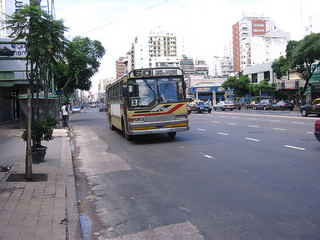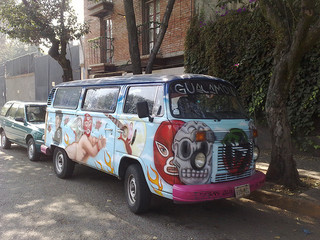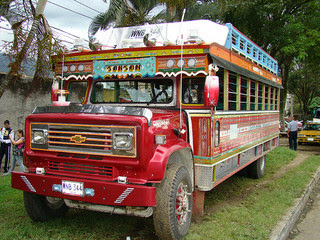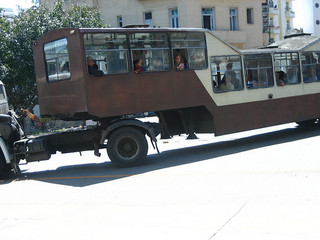Let’s start with el autobús. This is the most standard and universally understood way to refer to a bus. No matter where you are in Latin America or Spain, you can always say, “Quiero tomar el autobús (I want to take the bus),” and still be understood.
Colectivos and bondis
 |
| A colectivo halting at a Buenos Aires parada Photo credit: Ernesto licensed CC BY-SA 2.0 |
These vehicles operate along certain routes picking up and dropping off passengers along the way. Tickets for trips on Buenos Aires colectivos used to be sold by the colectivero (driver) until the introduction of automatic ticket vending machines introduced in 1995.
Also known as bondis in Argentina, these vehicles have seen rapid decline at least in the capital lately and have extensively been replaced by modern, more comfortable, and eco-friendly vehicles known as ómnibus (already ubiquitous in Uruguay).
Combis and micros
 |
| La combi: Art on wheels! Photo credit: puercozon licensed CC BY-SA 2.0 |
They are notorious for being exceptionally dangerous because of their rash drivers but are, at the same time, extremely practical as the cheapest mode of transport within the city. They dash punishably fast from one street corner to another along all the major arterial city roads.
Smaller micros are locally known as combis. These too, like their Argentine counterparts, los colectivos, are rapidly being replaced by the more sophisticated and modern ómnibuses. Other than Perú, Bolivia and Chile also have these micros.
The rustic chivas
 |
| Una chiva: Note the doors and the roof-rack Photo credit: laloking97 licensed CC BY-SA 2.0 |
The Red Devils
 |
| The Red Devil of Panama City Photo credit: tannazie licensed CC BY-SA 2.0 |
These buses are characteristically adorned with dramatic graffiti and streamers with the designated routes painted across their windshields and yelled out by the driver or their helper at regular intervals. The drivers are known for rash driving and have largely contributed to the vehicles being named, los diablos rojos (the red devils). They are also known for not adhering to their schedules or routes and keeping ther doors open during the drive due to being overwhelmingly overcrowded; but the per-commute ticket price of 25 cents makes these devils the most preferred mode of public transport in Panama City.
The guaguas of Santo Domingo
Also known as la guaguita, these are small, battered vans or trucks that cover fixed routes in the Dominican Republic as shared-taxis. Passengers are picked en route for maximum utilization which means these vehicles are filled to the brim with people and their baggage. Extremely uncomfortable and equally cheap, these buses stop operating by sun-down and usually connect only two major cities.
Smaller guaguas are usually called by the dimunitive form, guaguita. One theory is that this word came from the Quechua word, wáwa (small kids), due to these vehicles’ small size when they were first introduced. Another theory is that the word has Canarian origins. Guagua, incidentally, is also the word used for bus in Canary Islands, Puerto Rico, Cuba (where it’s also called wawa), parts of Chile, and even Spain!
The camels of Cuba
 |
| A brown camel in Old Havana Photo credit: Visentico/Sento licensed CC BY-SA 2.0 |
Elsewhere
El camión is the regular word for a bus in Mexico where el camión can also mean truck. Hence, to avoid ambiguity, a truck is also called el camión de carga.
Interested in knowing what other names exist for the bus or its variant in other Spanish-speaking cultures? Here’s an almost comprehensive list for fun:
Chile – liebre, góndola
Costa Rica – lata, bus, casadora
Honduras – burro
Mexico – calafia (a term used for a kind of minibus in the Baja California region), pecero
Perú – microbio
Venezuela – camionetica
















0 comments:
Post a Comment